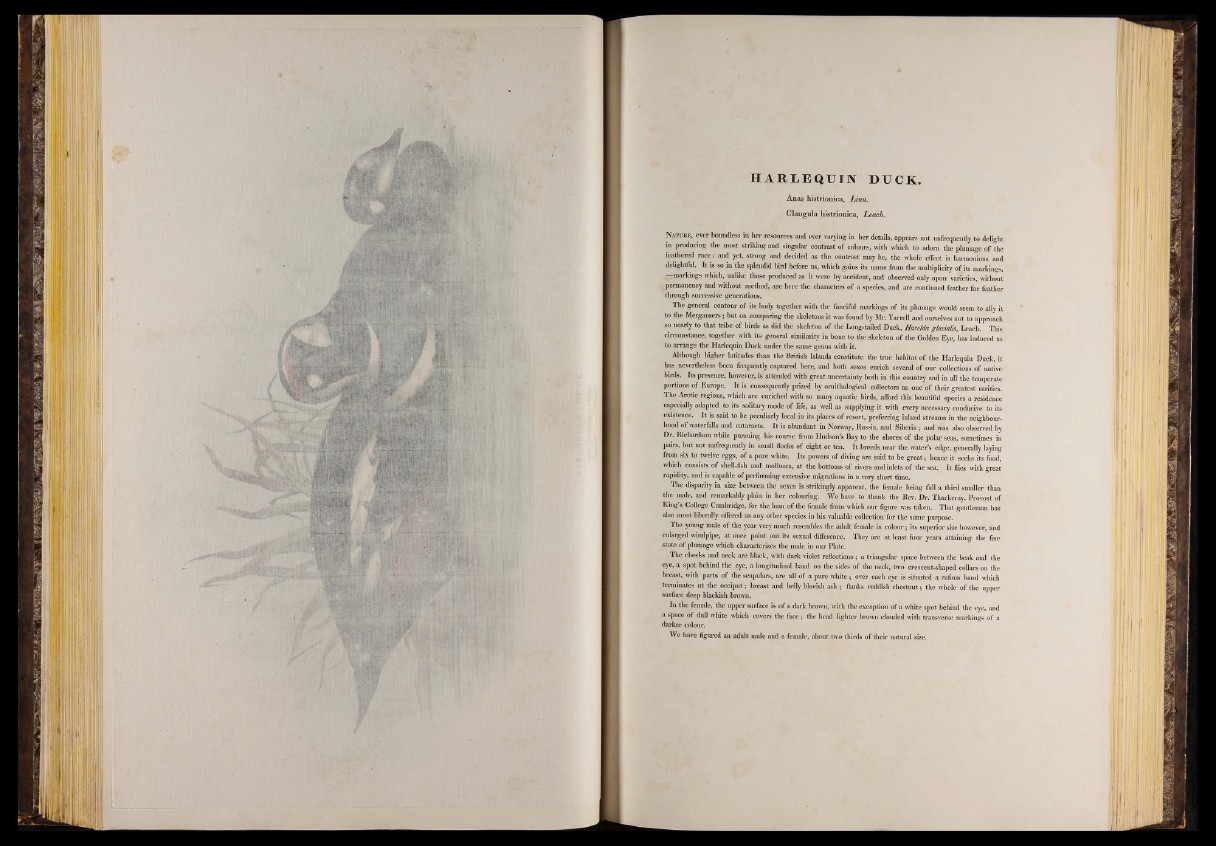
H A R L E Q U IN DUCK.
Anas histrionica, Linn.
Clangula histrionica, Leach.
N ature, ever boundless in her resources and ever varying in her details, appears not unfrequently to delight
in producing the most striking and singular contrast of colours, with which to adorn the plumage of the
feathered race: and yet, strong and decided as the contrast may be, the whole effect is harmonious and
delightful. It is so in the splendid bird before us, which gains its name from the multiplicity of its markings,
—markings which, unlike those produced as it were by accident, and observed only upon varieties, without
permanency and without method, are here the characters of a species, and are continued feather for feather
through successive generations.
The general contour of its body together with the fanciful markings of its plumage would seem to ally it
to the Mergansers; but on comparing the skeletons it was found by Mr. Yarrell and ourselves not to approach
so nearly to that tribe of birds as did the skeleton of the Long-tailed Duck, Barelda glachlis, Leach. This
circumstance, together with its general similarity in bone to the skeleton of the Golden Eye, has induced us
to arrange the Harlequin Duck under the same genus with it.
Although higher latitudes than the British Islands constitute the true habitat of the Harlequin Duck, it
has nevertheless been frequently captured here, and both sexes enrich several of our collections of native
birds. Its presence, however, is attended with great uncertainty both in this country and in all the temperate
portions of Europe. It is consequently prized by ornithological collectors as one of their greatest rarities.
The Arctic regions, which are enriched with so many aquatic birds, afford this beautiful species a residence
especially adapted to its solitary mode o f life, as well as supplying it with every necessary conducive to its
existence. It is said to be peculiarly local in its places o f resort, preferring inland streams in the neighbourhood
of waterfalls and cataracts. It is abundant in Norway, Russia, and Siberia; and was also observed by
Dr. Richardson while pursuing his course from Hudson’s Bay to the shores of the polar seas, sometimes in
pairs, but not unfrequently in small flocks of eight or ten. It breeds near the water’s edge, generally laying
from six to twelve eggs, o f a pure white. Its powers o f diving are said to be great; hence it seeks its food,
which consists of shell-fish and mollusca, at the bottoms of rivers and inlets of the sea. It flies with great
rapidity, and is capable of performing extensive migrations in a very short time.
The disparity in size between the sexes is strikingly apparent, the female being full a third smaller than
the male, and remarkably plain in her colouring. We have to thank the Rev. Dr. Thackeray, Provost of
King’s College Cambridge, for the loan of the female from which our figure was taken. That gentleman has
also most liberally offered us any other species in his valuable collection for the same purpose.
The young male of the year very much resembles the adult female in colour; its superior size however, and
enlarged windpipe, at once point out its sexual difference. They are at least four years attaining the fine
state of plumage which characterizes the male in our Plate.
fhe cheeks and neck are black, with dark violet reflections; a triangular space between the beak and the
eye, a spot behind the eye, a longitudinal band on the sides of the neck, two crescent-shaped collars on the
breast, with parts of the scapulars, are all o f a pure white; over each eye is situated a rufous band which
terminates at the occiput; breast and belly blueish ash; flanks reddish chestnut; the whole o f the upper
surface deep blackish brown.
In the female, the upper surface is of a dark brown, with the exception of a white spot behind the eye, and
a space o f dull white which covers the face; the head lighter brown clouded with transverse markings of a
darker colour.
We have figured an adult male and a female, about two thirds of their natural size.
08982080